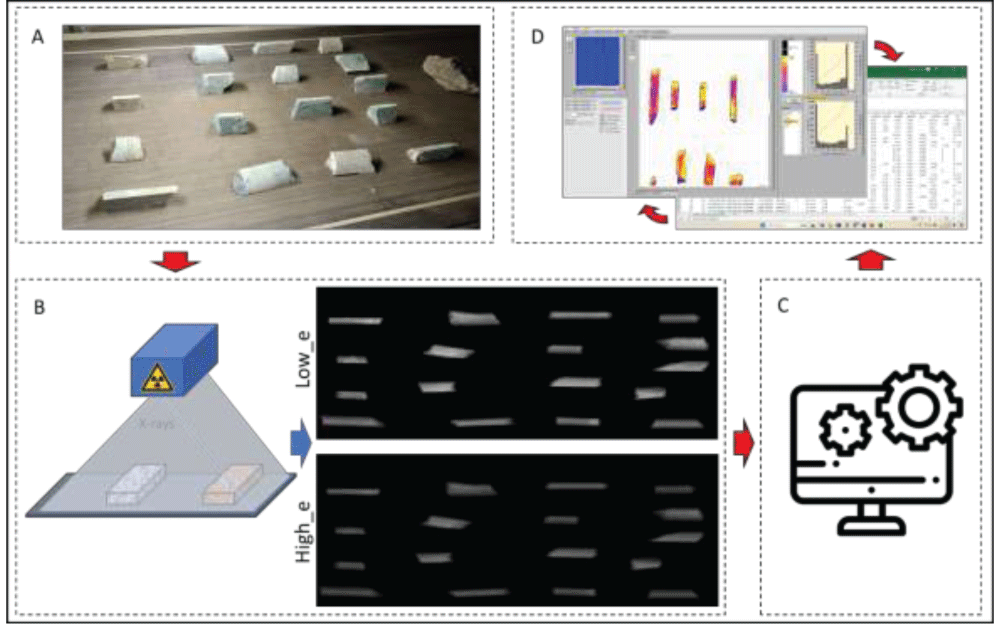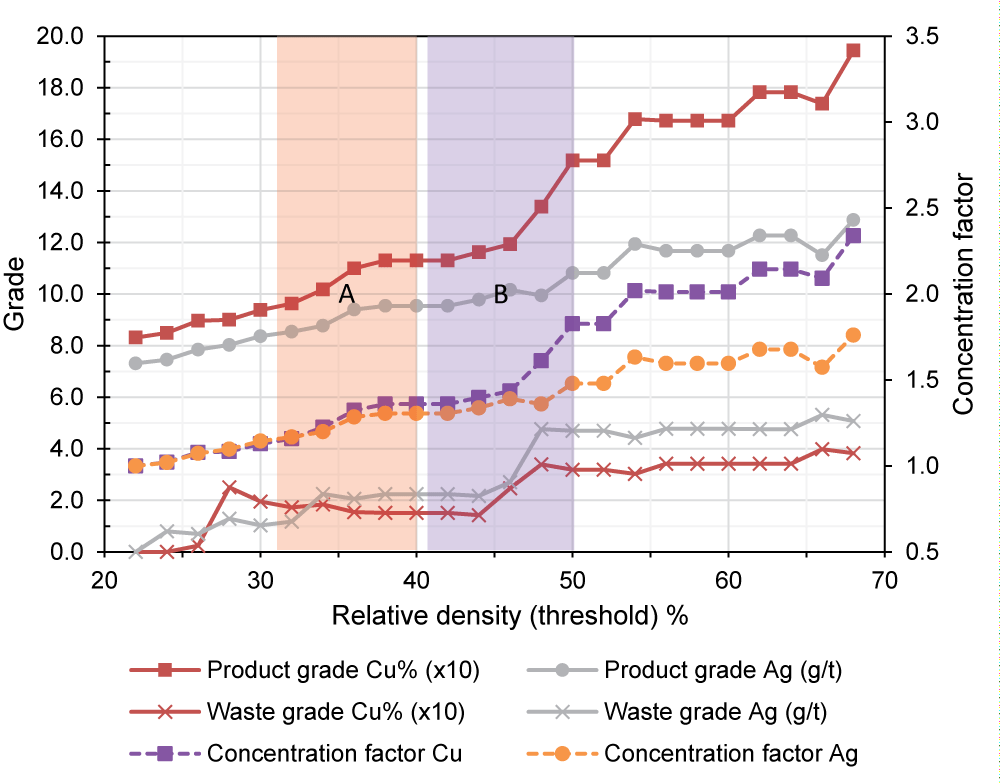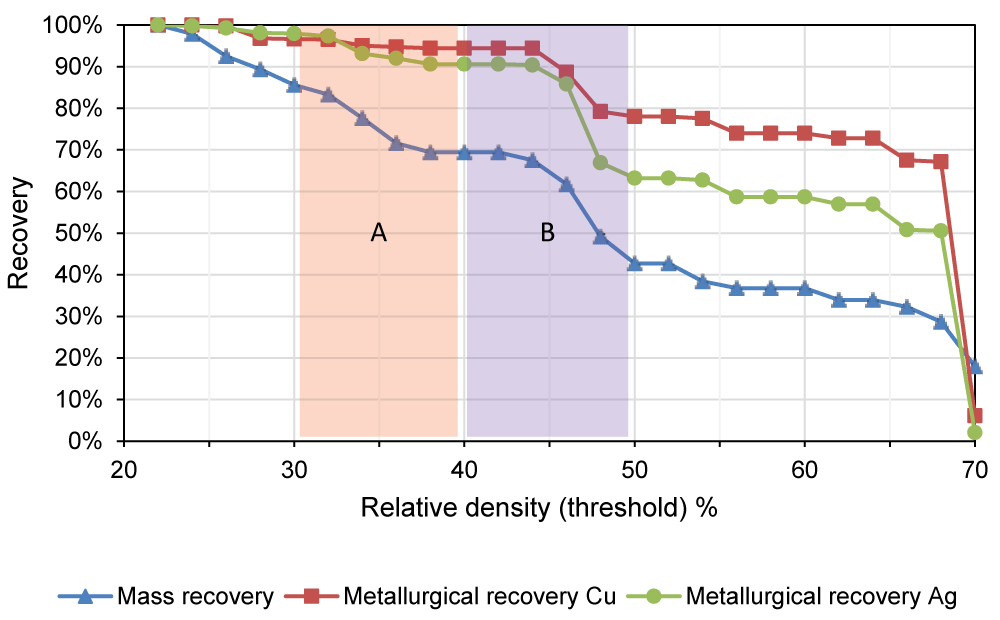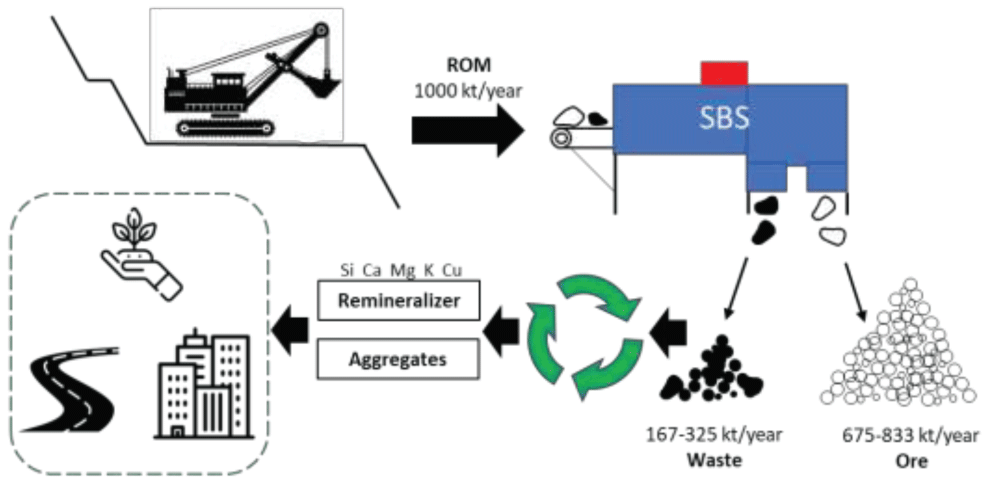
Sensor-based Sorting using De-XRT Sensor Applied to a Greenfield Copper Ore Project in Southern Brazil
Sensors Automation and Control Systems受け取った 30 Mar 2025 受け入れられた 06 Jun 2025 オンラインで公開された 10 Jun 2025
ISSN: 2995-8067 | Quick Google Scholar
Next Full Text
Investigation and Energy Modeling of New Generation Environmentally Friendly Energy Source Thorium Fueled Molten Salt Reactors


受け取った 30 Mar 2025 受け入れられた 06 Jun 2025 オンラインで公開された 10 Jun 2025
Copper is one of the most demanded minerals by the global industrial sector, with approximately 20 million tons mined worldwide each year. Silver, another important technical and precious metal, sees production around 26 kt/y. The general trend of declining average grades in these deposits has made mining low-grade ores a reality for many mines worldwide. Sensor-based sorting has emerged as a significant pre-concentration solution for these cases. This study investigates the applicability of this technique to copper ore samples from the Cerro do Andrade deposit, located in Caçapava do Sul, southern Brazil. The primary product of interest is copper (Cu), with silver (Ag) as a by-product. Pre-concentration tests are ongoing at the UFRGS Mineral Processing Laboratory (LAPROM) using a dual-energy X-ray transmission (DE-XRT) sensor sorter. Thirty-two ore samples were analyzed (64-16 mm size fraction). Relative density histograms and false-color images were generated. This data, along with Cu and Ag grades, was assessed in Excel to estimate recoveries (metallurgical and mass), concentration factors, and Cu and Ag grades in tailings fractions. Some scenarios of tailings generation and reuse were also explored. The analyzed samples had an average of 0.83% Cu and 7.31 g/t Ag. Pre-concentration simulations produced Cu grades in the product ranging from 0.9% to 1.0% and Ag grades of 7.8 to 8.8 g/t in the Range A. Waste grades ranged from 0.02% to 0.20% Cu and 0.7 - 2.2 g/t Ag. Range B exhibited more stable Cu and Ag grades in the product (around 0.9% Cu and 11 g/t Ag). Mass recoveries ranged from 92% - 77% in the Range A and reached 70% in the Range B. Metallurgical recoveries remained high: 99% - 95% Cu in the Range A and above 94% in the Range B. Silver recoveries were also promising (99% - 93% in Range A, 90% in Range B). Considering a feed of 1,000 kt/y, estimated ROM mass after pre-concentration ranged from 833-675 kt/y of product and 167 - 325 kt/y of coarse tailings. Reuse possibilities as remineralizers and civil aggregates hold promise. These preliminary findings indicate strong potential, demonstrating the potential for achieving significant outcomes through the implementation of sensor-based sorting pre-concentration in the Andrade Project.
Copper (Cu) is one of the most demanded minerals by the global industrial sector, with approximately 20 million tons (Mt) mined worldwide each year [1]. Silver (Ag), another important technical and precious metal, sees production around 26 kt/y. The general trend of declining average grades in these deposits has made mining low-grade ores a reality for many mines worldwide, as documented by various authors [2-6].
Seeking alternatives to address the reduction in deposit grades, sensor-based sorting has emerged as a significant pre-concentration solution [7,8]. These techniques offer additional benefits to projects, such as [7,9-12]:
Murphy, et al. [13] also demonstrate the potential impact of introducing pre-concentration processes. While in traditional routes the costs tend to increase steadily as ore grades decline, the incorporation of pre-concentration process can mitigate this cost progression due to the benefits provided by sensor-based sorting techniques. However, only SBS techniques cannot achieve the concentration factors required for major mineral commodities, due to the limited degree of liberation achievable in the particle size ranges handled by such equipment [14].
On the other hand, flotation typically requires grinding large amounts of gangue minerals to particle sizes below 200 µm, resulting in high demand for grinding components and energy. Therefore, combining pre-concentration and concentration methods appears to be the logical path forward for the modern mineral industry [14].
Therefore, considering the sensor-based sorting pre-concentration a method aligned perfectly with the need for cost reduction (both environmental and financial) and the rational exploitation of deposits, this study focuses on the Cerro do Andrade deposit (Andrade Mine) located in the southern Brazilian city of Caçapava do Sul/RS. Copper exploration in this area dates back to the early 20th century, with intensified activities starting in 2009. A Scoping Study [15] released in that year confirmed the technical and economic viability potential of the "Andrade Project", but without considering the use of pre-concentration. This present work aims to present preliminary results of ongoing studies analyzing the applicability of sensor-based sorting techniques to the pre-concentration of this ore, considering Cu as the main product and Ag as a by-product.
Pre-concentration tests are currently underway utilizing a sensor-based sorter model Comex Lab. Sorter, installed at the Laboratory of Mineral Processing (LAPROM) at UFRGS facilities. In this work, a dual-energy X-ray transmission (DE-XRT) sensor was employed and, to represent both the main grade and mineralogical variations, were collected 32 copper ore drilling samples, within a size fraction of 64 to 16 mm (-2 ½”+5/8”). These samples were analyzed by this sensor and the Comex ore-sorter software, generating false-color images composed by low and high energy data, which present the relative density information.
According to the Figure 1, the first step was to position the samples on the conveyor belt (A), the second was submit the samples to the DE-XRT sensor (B) generating images from two levels of energy (high and low). These images were then processed using the Comex software (C), generating a false-color image, where the red-yellow colors refers to high density areas and purple-blue areas correspond to low density. The last step (D) shows the generating of histograms from each sample, where pixel counts are grouped into 5% intervals, the average relative density from each sample was calculated using the equation below [16]:
 Figure 1: Sample testing scheme using the DE-XRT sensor, being: (A) samples on the conveyor belt, (B) generation of both low and high energy images, (C) image processing by the Comex software and (D) analysis of image data and data processing in Excel spreadsheets.
Figure 1: Sample testing scheme using the DE-XRT sensor, being: (A) samples on the conveyor belt, (B) generation of both low and high energy images, (C) image processing by the Comex software and (D) analysis of image data and data processing in Excel spreadsheets.(1)
Where: fi = pixels count in the bin, xi = central value of the interval, Σfi = total of pixels.
The grades of Cu, Ag, and other major oxides were analyzed by atomic absorption spectroscopy and X-ray fluorescence for each sample individually. Mineralogical analysis of gangue and ore minerals was performed using scanning electron microscopy (SEM/EDS) and X-ray diffraction on select samples.
Following analysis, this data was processed in Excel spreadsheets, due its user-friendly interface and the wide use in the industry. Therefore, the average relative densities and Cu-Ag grades were used to estimate recoveries (metallurgical and mass), concentration factor, and ore grades in the waste through simulated thresholds ranging from 22% to 70% with a 2% interval, considering the mass of each sample as well. Scenarios for tailings generation and reuse were also simulated within the Excel spreadsheets, based on data from the Company's Scoping Study [15].
As illustrated in Figure 2, Cu and Ag grades exhibit similar trends in almost all analyzed samples. This behavior is attributed to the colocalization of both elements within the structure of the same sulfide molecules, with the main sulfide minerals being chalcocite and chalcopyrite. Cu is the main economic product of both sulfides and Ag is a byproduct mainly associated with chalcopyrite ore, occurring as inclusions. The average grade of this specific group of samples selected for the classification tests is 0.83% Cu and 7.31 g/t Ag. The gangue minerals are primarily quartz, plagioclase, micas and chlorite.
Based on the estimated results for pre-concentrating this ore using the DE-XRT sensor, Figure 3 demonstrates that the Cu and Ag grades exhibit a significant change starting at the 26% threshold and continue to increase up to the 34% threshold. Within this range, Cu grades in the product range from 0.9% to around 1% and Ag grades ranging from 7.8 to 8.8 g/t, with a concentration factor of up to 1.2. In the tailings, Cu grades range between 0.02% and 0.20%, while Ag grades range between 0.7 and 2.2 g/t.
 Figure 3: Results of simulating different thresholds for concentration factor and waste grade in the pre-concentration using the DE-XRT sensor data. The shaded areas in the graph represent Ranges A and B.
Figure 3: Results of simulating different thresholds for concentration factor and waste grade in the pre-concentration using the DE-XRT sensor data. The shaded areas in the graph represent Ranges A and B.In the subsequent points, a plateau can be observed, ranging from the 36% to the 44% threshold, where the Cu and Ag grades remain relatively stable. In the product, Cu grades range from 1.10 to 1.16% and Ag grades from 9 to 10 g/t, with a concentration factor of approximately 1.3. In the reject, Cu grades remain around 0.15% and Ag grades around 2.0 g/t.
An analysis of both these distinct zones reveals two main possible ranges of thresholds that can be established for calibrating the sensor-based sorting equipment (Figures 3,4), being:
Range A refers to a more conservative threshold, between the relative densities 26 and 34%, where reject grades are minimized but product grade gains are smaller. In other words, a range focused on eliminating reject material with minimal false negatives;
Range B: A less conservative range, between the relative densities 36 and 44%, allowing for a more significant increase in product grades, but with the risk of excessive metal losses to the tailing stream, which could negatively impact the process.
The Figure 4 further complements the discussion by illustrating the metallurgical and mass recoveries achieved for Cu and Ag when simulating results at each relative density threshold. Reinforcing the observations regarding Ranges A and B, it is evident that the projected mass recovery for the product undergoes a significant change as the relative density threshold increases. The mass recovery decreases from 92% to 77% within Range A, and within the same range, the metallurgical recovery of Cu exhibits a slight decline, from 99% (at the 26% threshold) to 95% (at the 34% threshold). Ag experiences a somewhat more substantial drop in recovery, reaching 93% (at the 34% threshold). However, for both minerals, the 32% threshold stands out, where metallurgical recoveries exceed 97% for both Cu and Ag, while simultaneously projecting a 17% of rejected mass (tailings).
 Figure 4: Recovery results obtained by simulating of different thresholds. The shaded areas in the graph represent Ranges A and B.
Figure 4: Recovery results obtained by simulating of different thresholds. The shaded areas in the graph represent Ranges A and B.In Range B, metallurgical recoveries remain above 94% for Cu and above 90% for Ag. However, mass recoveries in the product indicate a potential for even greater reduction, reaching around 30%. This could be highly beneficial in terms of mitigating grinding costs, consumables, and other expenses. However, this potential benefit should be carefully evaluated against the economic and environmental implications of a slight decrease in metallurgical recoveries and need be evaluated.
The simple fact of being able to eliminate a significant fraction of the gangue minerals before the concentration and grinding processes can already be considered a benefit, but when there is the possibility to utilize these tailings economically, the results are even better. Taking into account the information from the scoping study, which estimates an annual extraction of 1,000 kt/y of ROM material, Table 1 presents the quantities from both coarse tailings and product perspectives. These values consider the feasibility of implementing a sensor-based sorting system calibrated according to the parameters discussed above.
| Table 1: Estimates of product and tailings tonnage that would be obtained at three different thresholds. | ||||
| Threshold | ROM (kt/y) | Pre-concentration | ||
| Range | Apparent density | Product (kt/y) | Tailings (kt/y) | |
| A | 32% | 1,000 | 833 | 167 |
| B | 38% | 1,000 | 694 | 306 |
| 44% | 1,000 | 675 | 325 | |
As a potential application for these waste rocks, the production of soil remineralizers has seen increasing demand in agriculture. Notably, the gangue composition contains important nutrients required by Brazilian regulations [17,18], the preliminary comparison between legal requirements and estimated waste contents can be seen in Table 2.
| Table 2: Comparison between estimated waste contents and Brazilian legal requirements, showing its potential of the use as a remineralizer. | |||
| Component | Waste contents | Eq. legal requirements | Reference |
| CaO | 7.04% | - | MAPA [17] |
| MgO | 4.50% | - | MAPA [17] |
| K2O | 0.92% | - | MAPA [17] |
| Ʃ | 12.46% | ≥ 9% | MAPA [17] |
| SiO (free) | 55.85% | ≥ 25% | MAPA [17] |
| K2O | 1.19% | ≥ 1% | MAPA [17] |
| Pb | 4.2 ppm | ≤ 200 ppm | MAPA [17] |
| Cd | < 0,5 ppm | ≤ 10 ppm | MAPA [17] |
| As | 6,5 ppm | ≤ 15 ppm | MAPA [17] |
Additionally, producing aggregates for civil construction (e.g., crushed stone and boulders) offers an alternative use, as depicted in Figure 5, both these scenarios giving favorable prospects for reusing the generated waste rock. On the other hand, regardless of the specific form of destination or reuse assigned to these coarse tailings, the direct reduction in ROM mass from 1,000 kt to 833-675 kt already represents a favorable factor to the processing plant operation.
 Figure 5: Potential flowchart of pre-concentrate generation using sensor-based sorting technology and possibilities for utilization of its coarse tailings.
Figure 5: Potential flowchart of pre-concentrate generation using sensor-based sorting technology and possibilities for utilization of its coarse tailings.These preliminary results hold great promise, demonstrating the potential for achieving significant outcomes through the implementation of sensor-based sorting pre-concentration in the Andrade Project. Notably, the results highlight the potential enhancement of the ROM grade within two distinct ranges: Range A and Range B, characterized as more and less conservative approaches, respectively. By adopting Range A, the grade increase ranges from 1.07 to 1.20 times, while in Range B, the grade increase can reach up to 1.3 times for Cu. For the Cu grades in the tailings, their values consistently remain below 0.2% in the Ranges A and B, aligning closely with the cut-off grade established in the Company’s Scoping Study. For Ag, the tailings’ grade remains between 0.7 and 2.2 g/t.
Regarding recoveries, both metals exhibit similar behavior, which was expected given their mineralogical characteristics. However, it is important noting the gradual reduction in mass recovery observed up to the beginning of Range B, without significant changes in metallurgical recoveries, particularly for Cu. Beyond this point (specifically, starting at the 38% threshold) mass recovery remains relatively stable. However, there is a slight decline in Ag metallurgical recovery, suggesting that adopting thresholds above 38% would not produce significant gains that would justify the risks associated with increased metal losses, suggesting that the optimal calibration threshold would be between 32 and 38%. Furthermore, understanding and utilizing this flexibility in threshold selection throughout the project’s lifespan can be an interesting tool, allowing for different ranges based on the specific mining zone being exploited.
About the disposal or reuse of generated coarse tailings (rejections), considering them as aggregates for civil construction or remineralizers for agriculture presents viable alternatives. However, the feasibility of such utilization is directly linked to the decision regarding a more or less conservative pre-concentration approach (Range A or B). Notably, the quantities generated with a lower threshold may make it more attractive to incorporate this small volume into the mine’s sterile material. Furthermore, from an ore valuation perspective, additional options may warrant further study.
Overall, this preliminary study provides significant insights the ongoing feasibility assessments of applying pre-concentration in the Andrade Project. As our studies progress, including concentrating essays, we anticipate that the sensor-based sorting technique will yield substantial benefits for the project’s economic and environmental evaluation. These benefits include ROM mass reduction, grade enhancements, and other potential outcomes such as reduced estimated milling and flotation consumption, lowering the cut-off grade at the mine and improving operational consistency.
We express our gratitude to the Brazilian Council for Scientific and Technological Development (CNPq), the Aguia Resourses and RAD companies and the Federal University of Rio Grande do Sul, particularly through its Laboratory of Mineral Processing (LAPROM).
dos Santos EG, de Brum IAS, Ambrós WM. Sensor-based Sorting using De-XRT Sensor Applied to a Greenfield Copper Ore Project in Southern Brazil. IgMin Res. April 24, 2025; 3(4): 201-205. IgMin ID: igmin299; DOI:10.61927/igmin299; Available at: igmin.link/p299
次のリンクを共有した人は、このコンテンツを読むことができます:
UFRGS - Federal University of Rio Grande do Sul, Porto Alegre, Brazil
Address Correspondence:
Evandro Gomes dos Santos, UFRGS - Federal University of Rio Grande do Sul, Porto Alegre, Brazil, Email: [email protected]
How to cite this article:
dos Santos EG, de Brum IAS, Ambrós WM. Sensor-based Sorting using De-XRT Sensor Applied to a Greenfield Copper Ore Project in Southern Brazil. IgMin Res. April 24, 2025; 3(4): 201-205. IgMin ID: igmin299; DOI:10.61927/igmin299; Available at: igmin.link/p299
Copyright: © 2025 dos Santos EG, et al. This is an open access article distributed under the Creative Commons Attribution License, which permits unrestricted use, distribution, and reproduction in any medium, provided the original work is properly cited.
 Figure 1: Sample testing scheme using the DE-XRT sensor, bei...
Figure 1: Sample testing scheme using the DE-XRT sensor, bei...
 Figure 2: Cu and Ag grades from the 32 samples analyzed....
Figure 2: Cu and Ag grades from the 32 samples analyzed....
 Figure 3: Results of simulating different thresholds for con...
Figure 3: Results of simulating different thresholds for con...
 Figure 4: Recovery results obtained by simulating of differe...
Figure 4: Recovery results obtained by simulating of differe...
 Figure 5: Potential flowchart of pre-concentrate generation ...
Figure 5: Potential flowchart of pre-concentrate generation ...